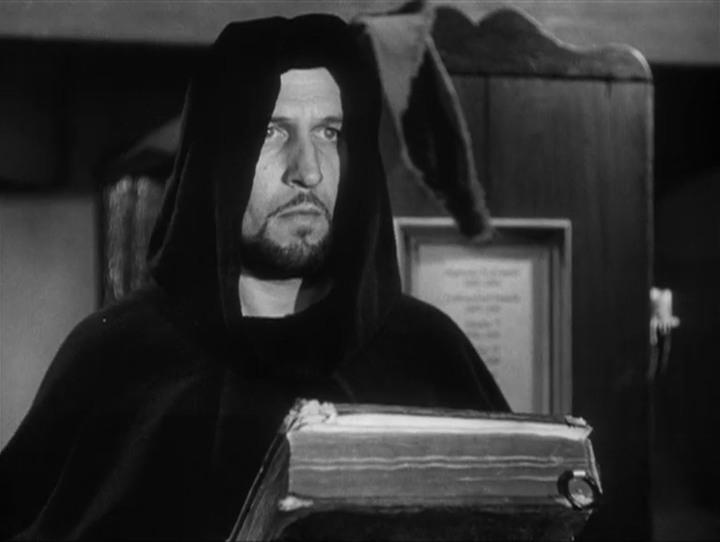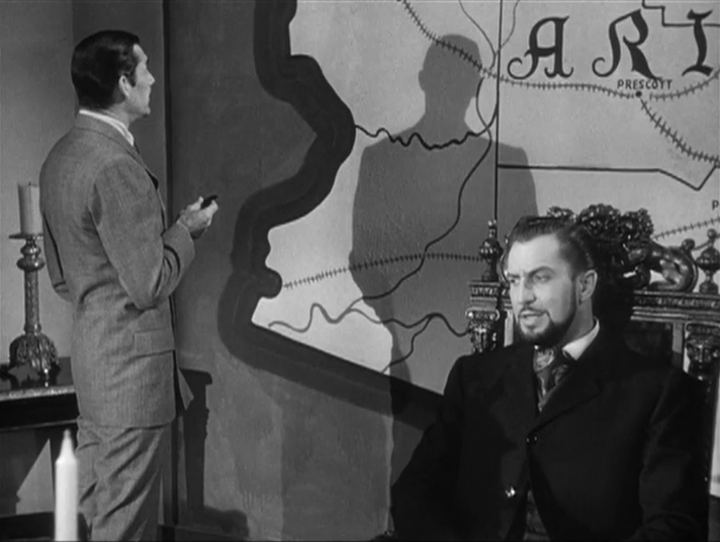“Gentlemen, it has the stench of swindle.”
|

Synopsis:
In late-1800s America, a talented con-artist named James Reavis (Vincent Price) plots an elaborate scheme to establish young Sofia (Karen Kester) — a peasant girl cared for by her adopted father (Vladimir Sokoloff) — as a Spanish baroness whose ancestors held a claim on Arizona territory. Reavis becomes a monk and then a gypsy in Spain in order to forge original land-grant documents, then returns and marries Sofia (now Ellen Drew) — but his claim to be Baron of Arizona infuriates all citizens, and sparks an investigation by a known forging expert (Reed Hadley).
|
|
Genres, Themes, Actors, and Directors:
- Beulah Bondi Films
- Con-Artists
- Historical Drama
- Mistaken or Hidden Identities
- Sam Fuller Films
- Vincent Price Films
Response to Peary’s Review:
As Peary writes, Sam Fuller’s second directorial feature — made after I Shot Jesse James (1949) and just before The Steel Helmet (1951) — is a “weird film even for [Fuller].” Peary argues that the “film is too claustrophobic and slow-moving, but keeps attention because [its] premise is so unusual”, and points out that “despite being set in gorgeous Arizona, [the] low budget of the film required that scenes take place indoors or at night” (a backdrop of an enormous map of the Arizona Territory serves as a pivotal visual in many scenes). I’m essentially in agreement with Peary’s assessment: despite its limitations, it’s impossible not to be fascinated by this fantastic tale given its historical basis and the inspired casting of Vincent Price in the lead, who inevitably heightens the surreality and melodrama of the proceedings. There’s some truly ripe dialogue:
“I’ll want you until the day I die. It is not death, it is dying that alarms me. It is not your crime, it is your weakness that alarms me.”
… which somehow doesn’t feel entirely out of place. James Wong Howe’s cinematography adds to the atmosphere of this hard-to-classify low-budget western crime-caper love-story.
Redeeming Qualities and Moments:
- A compelling and unusual storyline



- James Wong Howe’s cinematography


Must See?
Yes, once, as a novel story by a unique director.
Categories
Links:
|






One thought on “Baron of Arizona, The (1950)”
Yes, a once-must, as a very unique film.
I’ll have to disagree with Peary on this one, since I consider it to be among Fuller’s best work – even if it remains little-known / little-talked-about. I don’t think there’s anything “weird”, “claustrophobic” or “slow-moving” about it. Quite the contrary, I think it’s riveting throughout.
I’ll admit that it’s unusual subject matter for a film – and, on the surface, a story of fraud may not seem ‘action-packed’ enough, esp. for someone like Fuller to undertake. However, Fuller found the way to make the under-handedness of it all satisfyingly dramatic.
I have a personal interest in stories such as this – not just fraud for financial gain (though, re: forgery, Orson Welles’ ‘F for Fake’ is just as successful, in documentary style) but stories about people who lie on a grand scale and present themselves as something they’re not. (That could very well be why Hitchcock’s ‘Shadow of a Doubt’ is my favorite Hitch film, though it also happens to be a flawless film anyway.) It would be interesting to see an actual list of films that are mainly about fraud of some kind – but ‘TBOA’ stands out as unique, for its particular angle (land-grabbing and manipulation by way of extensive, false documentation).
The film afforded Price a real breakout opportunity as a lead and he took full advantage, impressively navigating a role that requires him to shift his personality traits often. It’s a strong performance and, as he almost always does, Vincent commands our attention. (The link – in the assessment – to the bio of the real James Reavis is valuable for learning what the film doesn’t or hasn’t time to show.)
James Wong Howe’s work as DP is also a major plus here (the only time he filmed Fuller’s work).
I’d only seen this film once before – years ago, during a retrospective of Fuller films. I thought, then, that it was an impressive work and, seeing it again years later, it still seems underrated.